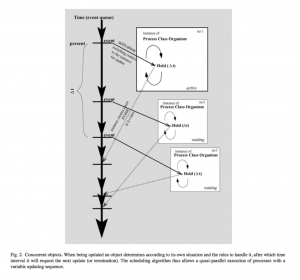Emergent properties in individual-based ecological models-introducing case studies in an ecosystem research context
Breckling, Broder, et al. “Emergent properties in individual-based ecological models—introducing case studies in an ecosystem research context.” Ecological modelling 186.4 (2005): 376-388.
In the paper, the authors present a series of case studies that use individual-based models. The authors focus on the emergent properties of these studies. They define emergent properties with three characteristics:
- they do not occur when considering the systems in isolation.
- at the higher levels they occur because of the interaction of the subsystems
- the phenomena that occur at the higher level cannot be deduced from investigating the lower level alone.
Studying these emergent phenomena from a modeling perspective allows us to understand if these patterns are driven from the micro-interactions between the subsystems. Emergent properties can help us decided with processes and on which level of organization contributes or is an boundary condition to the interacting dynamics of the other levels of organization.

An individual-based modeling approach was used for all the case studies. These are well-suited to do so because they allow for autecological relations of individuals to the environment and the population level. The authors also use a multi-scale approach, linking different organization levels, to investigate the overall ecosystem dynamics and how the state of the system feedback to provide the specifications of the interaction conditions. Multiscale modeling increaes the internal connectivity of the ecological system analyses.
In the case studies, they deal with specific aspects.
- Link individual behavior to eco-energetics and nutrient balances.
- Spatial organization of a population
- Development of modular organisms
These are investigated in 5 case studies:
- Jopp and Reuter (2005), Dispersal of Carabid Beetles—Emergence of Distribution Patterns; Reuter (2005), Community Processes as Emergent Properties: Modelling Multilevel Inter- action in Small Mammals Communities. (Modeling of population dynamics and dispersal in a terrestrial context)
- Hölker and Breckling (this volume), A spatiotemporal individual-based fish model to investigate emergent properties at the organismal and the population level. (Eco-energetics and spatial structure in fish populations
- Middelhoff and Breckling (2005), From single fine roots to a black alder for- est ecosystem: How system behaviour emerges from single component activities. (Plant nutrient uptake and fine root modular growth in alder trees)
- Eschenbach (2005), Emergent properties modelled with the functional structural tree growth model ALMIS: computer ex- periments on resource gain and use. (Shoot development and assimilation in alder trees, the ALMIS model)
